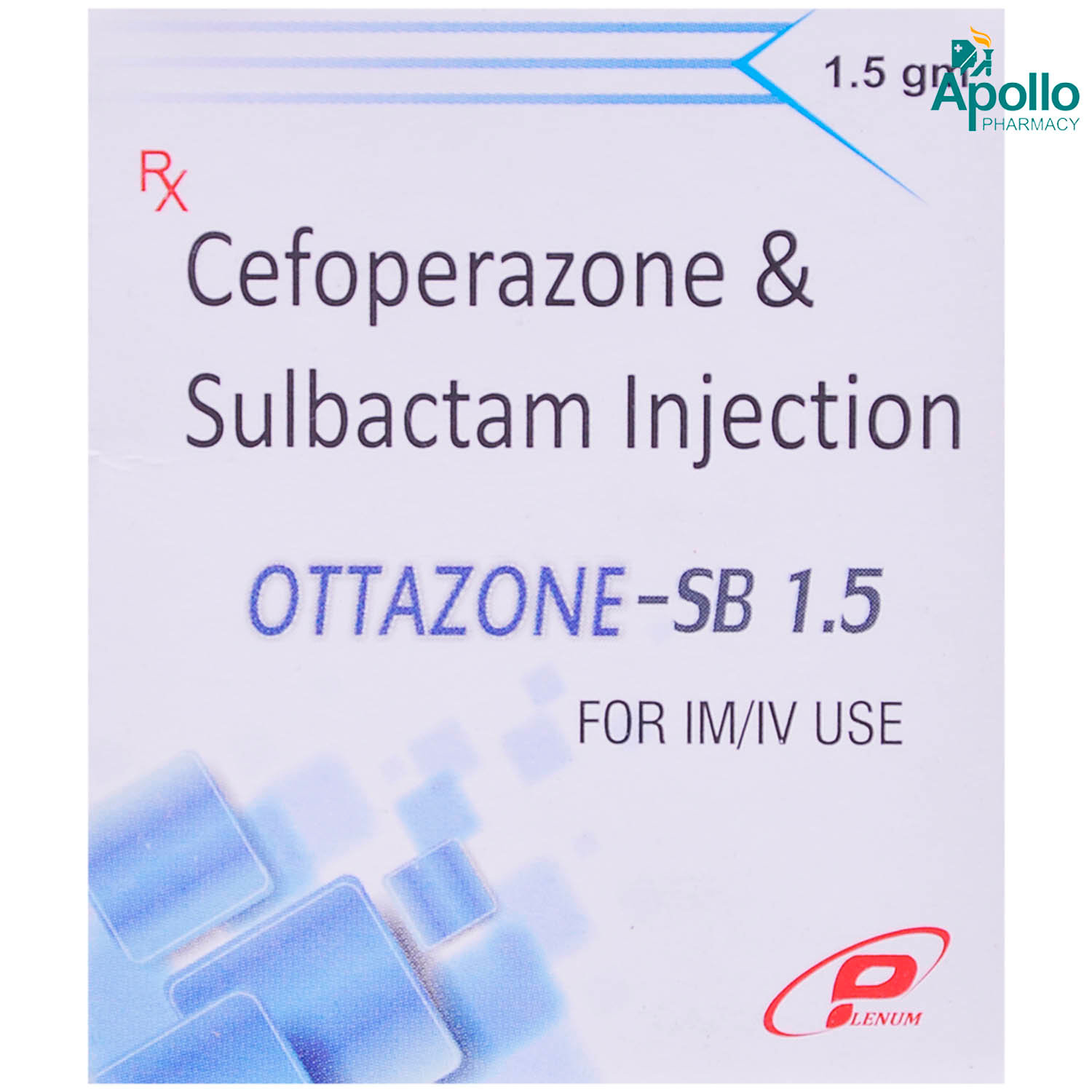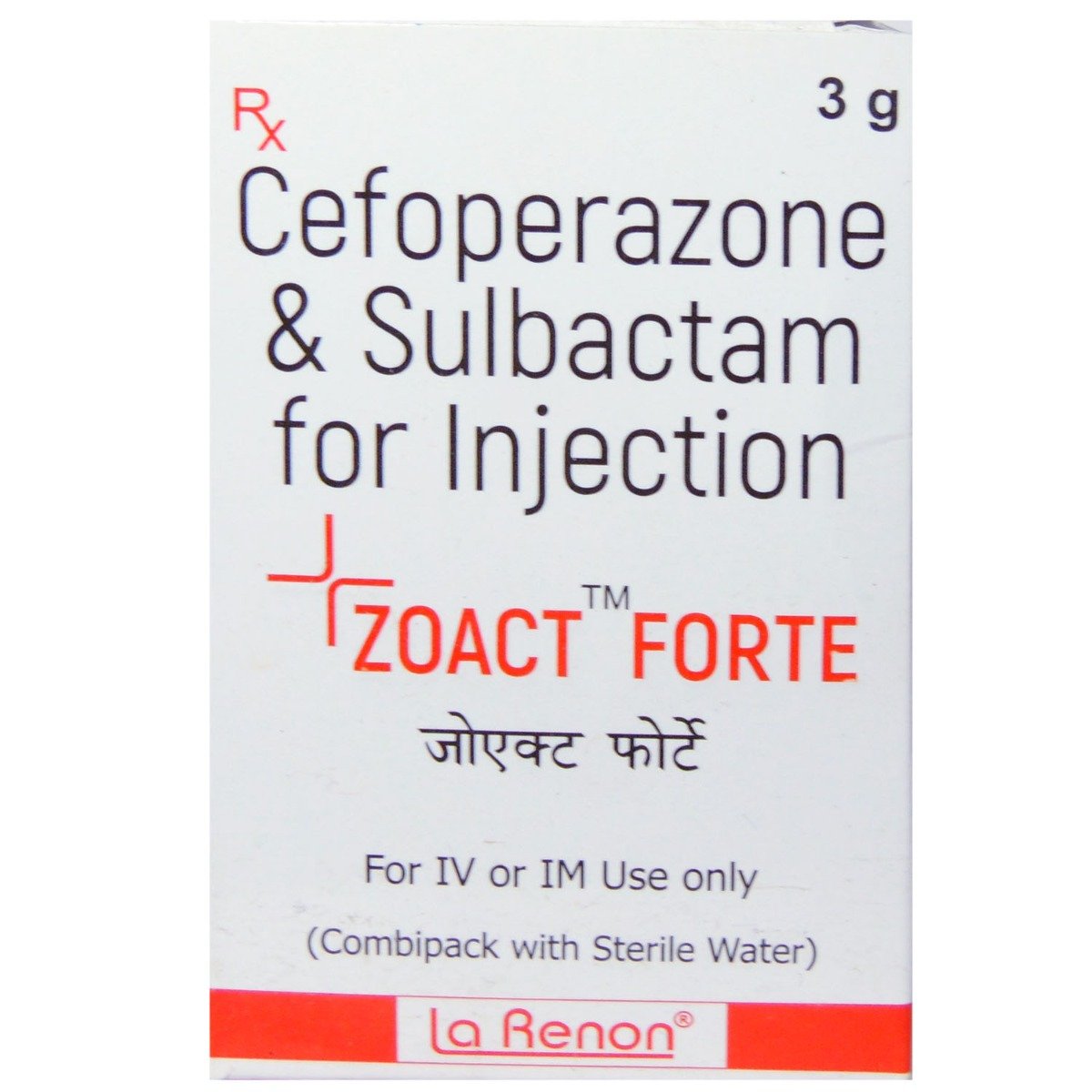Cefoperazone+sulbactam
About Cefoperazone+sulbactam
Cefoperazone+sulbactam belongs to the group of medicines called antibiotics used to treat various bacterial infections such as respiratory tract (lungs) infection, urine infection, blood infection, meningitis (inflammation of the brain and spinal cord), gonorrhoea (sexually transmitted disease), skin, abdominal, bone, and joint infections. Bacterial infections are caused due to the multiplication of harmful bacteria inside or on the body. Infectious or harmful bacteria can make you sick and reproduce quickly in your body. These harmful bacteria produce chemicals known as toxins, which can damage tissue and make you sick. Cefoperazone+sulbactam does not work against infections caused by the virus, including cold and flu.
Cefoperazone+sulbactam is a combination of two antibiotics, namely: Cefoperazone (cephalosporin antibiotic) and sulbactam (beta-lactamase inhibitor). Cefoperazone works by preventing the formation of bacterial cell covering, which is necessary for their survival. Thereby, kills the bacteria. On the other hand, sulbactam works by decreasing bacterial resistance and enhancing the activity of cefoperazone against the bacteria. Together, Cefoperazone+sulbactam helps to treat bacterial infections.
You may experience diarrhoea, allergic reaction, abnormal liver function tests, and anaemia (low number of red blood cells). Most of these side effects of Cefoperazone+sulbactam do not require medical attention and gradually resolve over time. However, if the side effects are persistent, reach out to your doctor.
Before starting Cefoperazone+sulbactam, please inform your doctor if you have any allergy (against any antibiotic), kidney or liver problems. Do not take Cefoperazone+sulbactam on your own as self-medication may lead to antibiotic-resistance in which antibiotics fail to act against specific bacterial infections. Consult your doctor before taking Cefoperazone+sulbactam if you are pregnant or planning for pregnancy. Avoid taking Cefoperazone+sulbactam if you are breastfeeding as Cefoperazone+sulbactam may pass into breast milk. Avoid alcohol consumption while taking Cefoperazone+sulbactam to prevent unpleasant side-effects.
Uses of Cefoperazone+sulbactam
Medicinal Benefits
Cefoperazone+sulbactam belongs to the group of medicines called antibiotics used to treat various bacterial infections such as respiratory tract (lungs) infection, urine infection, blood infection, meningitis (inflammation of the brain and spinal cord), gonorrhoea (sexually transmitted disease), skin, abdominal, bone, and joint infections. Cefoperazone+sulbactam is a combination of two antibiotics, namely: Cefoperazone (cephalosporin antibiotic) and sulbactam (beta-lactamase inhibitor). Cefoperazone works by preventing the formation of bacterial cell covering, which is necessary for their survival. Thereby, kills the bacteria. On the other hand, sulbactam works by decreasing bacterial resistance and enhancing the activity of cefoperazone against the bacteria. Together, Cefoperazone+sulbactam helps to treat bacterial infections.
Directions for Use
Storage
Side Effects of Cefoperazone+sulbactam
- Diarrhoea
- Allergic reaction
- Abnormal liver function tests
- Anaemia (low number of red blood cells)
Drug Warnings
After taking Cefoperazone+sulbactam if you have allergy-like symptoms including rash, swelling of the face/lips/throat, difficulty in breathing, or tightness in the chest, immediately contact your doctor. Do not take Cefoperazone+sulbactam if you have an allergy to Cefoperazone+sulbactam, cephalosporins penicillin class of antibiotics as it may cause a skin rash, itching, and difficulty in breathing. People having liver disease or jaundice (yellowing of skin/eye) should not take Cefoperazone+sulbactam, as it can damage your liver severely. You may have diarrhoea in some cases which can be managed by taking it with any probiotics and plenty of fluids. Do not take antacids along with Cefoperazone+sulbactam; maintain a gap of 2-3 hours between both. Avoid alcohol consumption while taking Cefoperazone+sulbactam to prevent unpleasant side-effects. Cefoperazone+sulbactam may cause dizziness, so be cautious while driving. Inform your doctor about all the medicines you are taking and about your health condition to rule out any unpleasant side-effects.
Drug Interactions
Drug-Drug Interactions: Cefoperazone+sulbactam may have interaction with a diuretic (furosemide), anticoagulants (warfarin), other antibiotics (gentamicin).
Drug-Food Interactions: No interactions found/established.
Drug-disease interactions: Cefoperazone+sulbactam may have interactions with colitis (inflammation in the lining of the colon), seizures, dialysis, kidney, and liver dysfunction.
Drug-Drug Interactions Checker List:
Safety Advice

Alcohol
cautionAvoid consuming alcohol while taking Cefoperazone+sulbactam as it cause increased side effects.

Pregnancy
cautionPlease consult your doctor if you are pregnant, your doctor will prescribe Cefoperazone+sulbactam only if the benefits outweigh the risks.

Breast Feeding
cautionA small amount of Cefoperazone+sulbactam may pass into breast milk. Avoid taking Cefoperazone+sulbactam if you are breastfeeding unless prescribed.

Driving
cautionCefoperazone+sulbactam may cause dizziness in some people, so it may affect your ability to drive.

Liver
cautionDose adjustment may be needed. Please consult your doctor before taking Cefoperazone+sulbactam if you have liver impairment/liver disease.

Kidney
cautionDose adjustment may be needed. Please consult your doctor if you have any concerns regarding this or if you have kidney impairment/kidney disease before taking Cefoperazone+sulbactam.

Children
safe if prescribedFor children, Cefoperazone+sulbactam is safe, Dose needs to be adjusted and recommended by a doctor.
Habit Forming
Diet & Lifestyle Advise
- Probiotics should be taken after taking the full course of Cefoperazone+sulbactam in order to restore some healthy bacteria in the intestines that may have been killed. Taking probiotics after antibiotic treatment can reduce the risk of antibiotic-associated diarrhoea. Certain fermented foods like yoghurt, cheese, sauerkraut, kombucha, and kimchi can help to restore the good bacteria of the intestine.
- Include more fibre-enriched food in your diet, as it can be easily digested by your gut bacteria, which helps stimulate their growth. Thus, fibre-rich foods may help restore healthy gut bacteria after a course of antibiotics. Whole grains like whole-grain bread, brown rice should be included in your diet.
- Avoid intake of alcoholic beverages with Cefoperazone+sulbactam as it can make you dehydrated and may affect your sleep. This can make it harder for your body to aid the Cefoperazone+sulbactam in fighting off infections.
Special Advise
- Do not skip any doses and finish the full course of treatment even if you feel better. Stopping it early may make the infection harder to treat.
- Discontinue Cefoperazone+sulbactam and inform your doctor immediately if you get a rash, itchy skin, swelling of face and mouth, or have difficulty in breathing.
- Diarrhoea may occur as a side effect but should stop when your course is complete. Inform your doctor if it does not stop or if you find blood in your stools.
- Cefoperazone+sulbactam is preferably taken with food to avoid an upset stomach.
- Some people may be allergic to Cefoperazone+sulbactam or other penicillin or cephalosporin group of antibiotics. So a prior sensitivity test may be necessary. Inform your doctor if you are allergic to any medicine particularly antibiotics belong to these groups.
- If you feel nauseous after taking Cefoperazone+sulbactam, stick to simple meals like porridge, khichdi, dal roti, and other home-cooked meals. Avoid spicy and fatty food.
Patients Concern
Disease/Condition Glossary
Bacterial infections: A bacterial infection is a condition in which harmful bacteria enter, multiply, and infect our body. Infectious or harmful bacteria can make you sick and reproduce quickly in your body. These harmful bacteria produce chemicals known as toxins, which can damage tissue and make you sick. It can target any body part and multiply very quickly. When you get infected with bacteria, you can experience generalized symptoms, like fevers, chills, and fatigue. Bacteria are of various forms comprising commonly of spherical, rod, and spiral-shaped. Bacterial infections vary from minor illnesses like sore throat and ear infections to severe brain infections like meningitis and encephalitis. Anyone can become infected with a bacterial infection. But, people with weak immune systems or taking immunosuppressive medicine are more prone to bacterial infection.
FAQs
No, do not stop taking Cefoperazone+sulbactam before completing the full course of treatment. You may start feeling better before the infection is completely cured. But, it is important to take this medicine for the full duration advised by your doctor.
Inform your doctor if you do not feel better even after finishing the full course of treatment. You must also inform your doctor if the symptoms get worse while using this medicine.
Usually, Cefoperazone+sulbactam starts working soon after taking it. Though, it may take a few days to kill all the dangerous bacteria and make you feel better.
Cefoperazone+sulbactam may cause Clostridium difficile-associated diarrhoea (CDAD). Treatment with antibiotics alters the normal flora leading to overgrowth of Clostridium difficile; this causes diarrhoea. Drink lots of fluids and eat food rich in fibre if you experience diarrhoea. If you find blood in stools (tarry stools) or if you experience prolonged diarrhoea with abdominal pain, stop taking Cefoperazone+sulbactam and consult your doctor. Do not take anti-diarrheal medicine on your own.
Yes, Cefoperazone+sulbactam is known to cause stomach upset. To avoid these side effects please take Cefoperazone+sulbactam with a meal. Also, Cefoperazone+sulbactam should be taken at evenly spaced intervals to avoid any unpleasant side effects and for best results.





